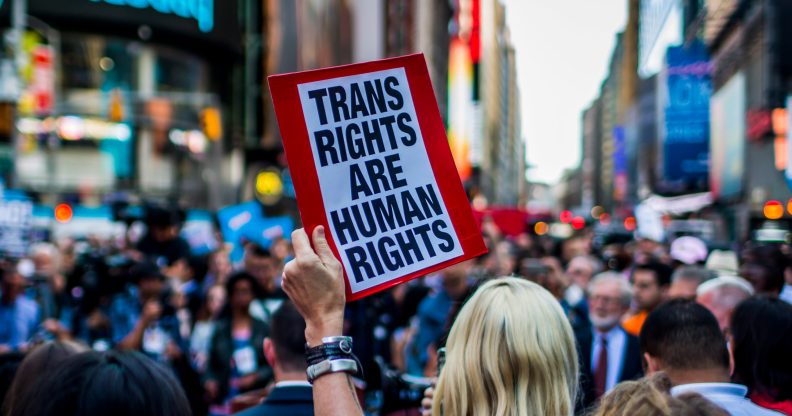Donald Trump’s cruel ban on trans people joining the military is officially over

Donald Trump’s vow to ban trans troops was met with fierce protest in 2017. (Michael Nigro/Pacific Press/LightRocket via Getty)
Pentagon policies that allow trans folk to serve in the US military went into effect Thursday (April 30), finally undoing Donald Trump’s cruel and unnecessary ban.
It was the upshot of a tug-of-war between administrations and a year of litigation but in 2019, the former president’s abrupt ban formally went into effect. Closing the ranks of the armed forces from trans folk.
The ban sowed not only unease for countless trans personnel but frustration for advocates at what was the latest in a long line of blows to LGBT+ rights dealt by Trump.
And for those trans folk eager to serve, they were left feeling like “caged animals” by the ban.
But in one of his first actions as president, Joe Biden swiftly lifted the ban in an executive order in January, with the Pentagon issuing revised guidelines in March that would go into effect one month later.
And that time is now.
What does the end of the trans military ban mean?
Among the new provisions, the military will now carve out services members a pathway to allow them to transition while serving.
They will no longer be discharged or denied reenlistment for being trans and will be able to serve and enlist openly in their correct gender.
Procedures to change gender markers in databases will be added, and the Defence Health Agency, which provides uniformed services health care, will offer gender-affirming healthcare options.
“These policies are based on the conclusion that open service by transgender persons who are subject to the same high standards and procedures as other service members with regard to medical fitness for duty, physical fitness, uniform and grooming standards, deployability, and retention is consistent with military service and readiness,” the department guidelines state.
Above all, the document says: “All service members must be treated with dignity and respect.”

President Joe Biden speaks at the Pentagon February 10, 2021. (Alex Brandon – Pool/Getty)
In restoring protections placed by the Obama administration, Biden put at ease thousands of trans service members and even more ready to join.
According to figures from Pentagon’s Office for Diversity, Equity and Inclusion, around 1,000 to 8,000 troops are trans.
Trump blindsided much of his own defence secretary as well as the Republican leadership when, under pressure from conservatives in 2017, he tweeted that he planned to ban trans troops.
The pace at which Trump announced the ban threw not only activists off guard, but his own White House. The New York Times reported at the time that officials struggled to answer basic questions about the plan.
At the time, Trump cited that American forces could not afford the “tremendous medical costs and disruption” of the trans community.
In 2019, the Defence Department estimated that the military has spent around $8 million on gender-affirming health since 2016 out of its $50,000,000,00 healthcare budget.
Activists sought to forestall the ban through various injunctions in the federal courts, only for the Supreme Court to give it the go-ahead.
But Biden made repealing the ban a bright line for him throughout his campaign and ascent into the Oval Office. And his administration did just that to mark Transgender Day of Visibility.
“The US military is the greatest fighting force on the planet because we are composed of an all-volunteer team willing to stand up and defend the rights and freedoms of all Americans,” a memo by defence secretary Lloyd Austin III on the day stated.
“And we will remain the best and most capable team because we avail ourselves of the best possible talent America has to offer, regardless of gender identity.”

